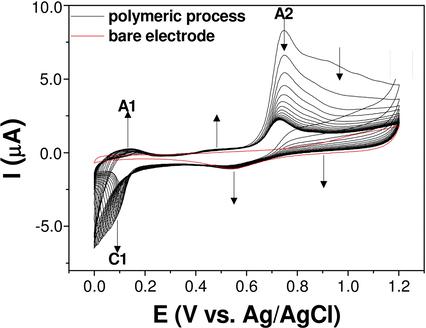当前位置:
X-MOL 学术
›
Electroanalysis
›
论文详情
Our official English website, www.x-mol.net, welcomes your
feedback! (Note: you will need to create a separate account there.)
Electrochemical Detection of Sialic Acid Using Phenylboronic Acid‐modified Poly(Diaminobenzoic Acid) Electrodes
Electroanalysis ( IF 2.7 ) Pub Date : 2017-12-14 , DOI: 10.1002/elan.201700634 Gabriela Broncová 1 , Pavel Matějka 2 , Zuzana Němečková 1 , Vladimír Vrkoslav 3 , Tatiana V. Shishkanova 1, 4
Electroanalysis ( IF 2.7 ) Pub Date : 2017-12-14 , DOI: 10.1002/elan.201700634 Gabriela Broncová 1 , Pavel Matějka 2 , Zuzana Němečková 1 , Vladimír Vrkoslav 3 , Tatiana V. Shishkanova 1, 4
Affiliation

|
This study is focused on the electrochemical detection of sialic acid (SA) using electrochemical impedance spectroscopy (EIS) and potentiometric approaches with the polymeric film derived from 3,4‐diaminobenzoic acid (3,4‐DABA) and modified with 3‐aminophenylboronic acid (3‐APBA). The polymeric film derived from 3,4‐DABA was prepared using cyclic voltammetry at 0.5 M H2SO4 on a platinum disc electrode from 0 to 1.20 V vs. Ag/AgCl and characterized by FTIR‐Raman spectroscopy. It has been found that the polymerization process goes through the amino group and a free carboxyl group serves for the covalent binding of 3‐APBA onto the polymeric backbone. Both the electrochemical approaches independently confirmed the recognition of SA by APBA‐modified PDABA electrodes. In contrast to known electrochemical sensors in the literature, the APBA‐modified PADABA sensor for SA gave a response in the range from 0.025 to 0.998 mM at neutral pH using the EIS method. The decrease in the EIS signal of ca 12 % was observed after two weeks of intensive use. Importantly, the selective APBA‐modified polymeric electrode enabled the use of SA determination in artificial urine samples in a concentration range that is useful for diagnostic purposes, specifically 12–102 μg mL−1.
中文翻译:

苯硼酸修饰的聚二氨基苯甲酸电极对唾液酸的电化学检测
这项研究的重点是使用电化学阻抗谱(EIS)和电位计方法对唾液酸(SA)进行电化学检测,该方法采用了3,4-二氨基苯甲酸(3,4-DABA)并经3-氨基苯硼酸修饰的聚合物膜(3-APBA)。在0.5 MH 2 SO 4下使用循环伏安法制备了3,4-DABA衍生的聚合物薄膜在相对于Ag / AgCl的0至1.20 V的铂圆盘电极上,并通过FTIR拉曼光谱进行表征。已经发现,聚合过程是通过氨基进行的,而游离的羧基则将3-APBA共价结合到聚合物主链上。两种电化学方法均独立地证实了APBA修饰的PDABA电极对SA的识别。与文献中已知的电化学传感器相比,使用EIS方法在中性pH值下,APBA改良的PADABA SA传感器在0.025至0.998 mM的响应范围内。密集使用两周后,EIS信号下降了约12%。重要的,-1。
更新日期:2017-12-14
中文翻译:

苯硼酸修饰的聚二氨基苯甲酸电极对唾液酸的电化学检测
这项研究的重点是使用电化学阻抗谱(EIS)和电位计方法对唾液酸(SA)进行电化学检测,该方法采用了3,4-二氨基苯甲酸(3,4-DABA)并经3-氨基苯硼酸修饰的聚合物膜(3-APBA)。在0.5 MH 2 SO 4下使用循环伏安法制备了3,4-DABA衍生的聚合物薄膜在相对于Ag / AgCl的0至1.20 V的铂圆盘电极上,并通过FTIR拉曼光谱进行表征。已经发现,聚合过程是通过氨基进行的,而游离的羧基则将3-APBA共价结合到聚合物主链上。两种电化学方法均独立地证实了APBA修饰的PDABA电极对SA的识别。与文献中已知的电化学传感器相比,使用EIS方法在中性pH值下,APBA改良的PADABA SA传感器在0.025至0.998 mM的响应范围内。密集使用两周后,EIS信号下降了约12%。重要的,-1。











































 京公网安备 11010802027423号
京公网安备 11010802027423号